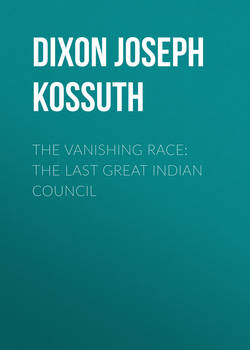Читать книгу The Vanishing Race: The Last Great Indian Council - Dixon Joseph Kossuth - Страница 16
THE STORY OF THE CHIEFS
Chief Brave Bear
ОглавлениеBrave Bear, in the language of the Cheyennes, of whom he is head chief, is Ni-go High-ez, Ni-go meaning bear, and High-ez, brave. This name he has kept to the standard on many a hard-fought field, and in helping to reconstruct his tribe in the ways of civilization. He is tactful and courteous, and his smile resembles the sunlight breaking a path across a darkened sheet of water; it is the most winsome that I have seen for years on the face of any man.
Showing the Indian's long continued aversion to any speech regarding the Custer battle, Brave Bear said: “I was in the battle of the Little Big Horn. The Indians called the General ‘Long Hair.’ It is a fight that I do not like to talk about.”
Just here it may be well to carry in our minds the distinction between the Northern and Southern Cheyennes. When the tribe was a compact whole they were constantly pressed farther into the plains by the hostile Sioux and established themselves on the upper branches of the Platte River. In consequence of the building of Bent's Ford upon the upper Arkansas in Colorado, a large part of the tribe decided to move south, the other section moving north to the Yellow-stone. The two sections of the one tribe have since been known officially as the Northern and Southern Cheyennes. Ever and again the Southern branch of the tribe came to the far north to help their brothers when in conflict. This may account for Brave Bear being present with the Northern Cheyennes in the Custer fight. Then came the story of Brave Bear concerning one of the battles in the south. “There is,” he said, “a Cheyenne called ‘Tall Bear’; he was the head man at the time we began to fight down on the Platte River. From that hard battle we were returning home. In front of us there were a lot of soldiers camped, and some of the Pawnee scouts were with the soldiers. We thought they were Pawnee tents, but when we came close enough we saw it was a soldier camp, and they fired upon us and pursued us. That day we kept on fighting, and they killed three of us. It was a great fight, and it still remains with me when I think about it.”
“I like the white man's way of living to-day better, because I feel that when the new day comes everything else is new, and the things of the white man grow new with every day. I try to do as our agent directs. I have never had any trouble with him.”
There is a touch of humanness about these tall, graceful, feather-bedecked men, willingly assuming the role of children, that they may learn the better ways of the white man. The hard ideals of the warpath are all merged in pursuing the path of peace.
